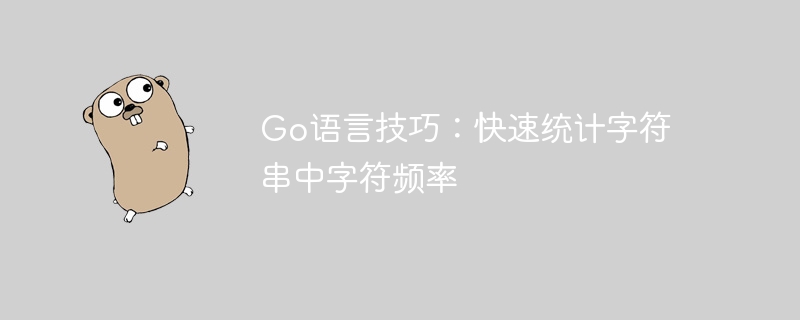 Backend Development
Backend Development
 Golang
Golang
 Go language skills: quickly count the frequency of characters in a string
Go language skills: quickly count the frequency of characters in a string
Go language skills: quickly count the frequency of characters in a string

Go language skills: Quickly count the frequency of characters in a string
In the Go language, counting the frequency of characters in a string is a common operation. By using the map data structure, we can implement this function quickly and efficiently. In this article, we will introduce how to use Go language to write code to count the frequency of characters in a string, with specific code examples.
First, we need to define a function to count the frequency of characters in a string. The code example is as follows:
package main
import (
"fmt"
)
func countCharacterFrequency(input string) map[rune]int {
frequency := make(map[rune]int)
for _, char := range input {
frequency[char]++
}
return frequency
}
func main() {
input := "Hello, World!"
frequency := countCharacterFrequency(input)
for char, count := range frequency {
fmt.Printf("Character '%c' appears %d times
", char, count)
}
}In the above code example, we have defined a function called countCharacterFrequency that accepts a string as input and returns a map where the key is the character and the value is the character The number of occurrences in the string. Then, in the main function, we call the countCharacterFrequency function, traverse the result map, and print out the number of occurrences of each character.
You can copy and paste the above code into a Go source file, and run the program, input a string, the program will count the frequency of each character in the string and output the results.
In this way, we can quickly and simply count the frequency of characters in a string, which is very useful for some application scenarios that need to process strings. I hope this little tip can help you make better use of the features of the Go language.
The above is the detailed content of Go language skills: quickly count the frequency of characters in a string. For more information, please follow other related articles on the PHP Chinese website!

Hot AI Tools

Undresser.AI Undress
AI-powered app for creating realistic nude photos

AI Clothes Remover
Online AI tool for removing clothes from photos.

Undress AI Tool
Undress images for free

Clothoff.io
AI clothes remover

Video Face Swap
Swap faces in any video effortlessly with our completely free AI face swap tool!

Hot Article

Hot Tools

Notepad++7.3.1
Easy-to-use and free code editor

SublimeText3 Chinese version
Chinese version, very easy to use

Zend Studio 13.0.1
Powerful PHP integrated development environment

Dreamweaver CS6
Visual web development tools

SublimeText3 Mac version
God-level code editing software (SublimeText3)

Hot Topics
 1662
1662
 14
14
 1418
1418
 52
52
 1311
1311
 25
25
 1261
1261
 29
29
 1234
1234
 24
24
 How to solve the user_id type conversion problem when using Redis Stream to implement message queues in Go language?
Apr 02, 2025 pm 04:54 PM
How to solve the user_id type conversion problem when using Redis Stream to implement message queues in Go language?
Apr 02, 2025 pm 04:54 PM
The problem of using RedisStream to implement message queues in Go language is using Go language and Redis...
 What is the problem with Queue thread in Go's crawler Colly?
Apr 02, 2025 pm 02:09 PM
What is the problem with Queue thread in Go's crawler Colly?
Apr 02, 2025 pm 02:09 PM
Queue threading problem in Go crawler Colly explores the problem of using the Colly crawler library in Go language, developers often encounter problems with threads and request queues. �...
 What should I do if the custom structure labels in GoLand are not displayed?
Apr 02, 2025 pm 05:09 PM
What should I do if the custom structure labels in GoLand are not displayed?
Apr 02, 2025 pm 05:09 PM
What should I do if the custom structure labels in GoLand are not displayed? When using GoLand for Go language development, many developers will encounter custom structure tags...
 In Go, why does printing strings with Println and string() functions have different effects?
Apr 02, 2025 pm 02:03 PM
In Go, why does printing strings with Println and string() functions have different effects?
Apr 02, 2025 pm 02:03 PM
The difference between string printing in Go language: The difference in the effect of using Println and string() functions is in Go...
 What libraries are used for floating point number operations in Go?
Apr 02, 2025 pm 02:06 PM
What libraries are used for floating point number operations in Go?
Apr 02, 2025 pm 02:06 PM
The library used for floating-point number operation in Go language introduces how to ensure the accuracy is...
 What is the difference between `var` and `type` keyword definition structure in Go language?
Apr 02, 2025 pm 12:57 PM
What is the difference between `var` and `type` keyword definition structure in Go language?
Apr 02, 2025 pm 12:57 PM
Two ways to define structures in Go language: the difference between var and type keywords. When defining structures, Go language often sees two different ways of writing: First...
 Which libraries in Go are developed by large companies or provided by well-known open source projects?
Apr 02, 2025 pm 04:12 PM
Which libraries in Go are developed by large companies or provided by well-known open source projects?
Apr 02, 2025 pm 04:12 PM
Which libraries in Go are developed by large companies or well-known open source projects? When programming in Go, developers often encounter some common needs, ...
 When using sql.Open, why does not report an error when DSN passes empty?
Apr 02, 2025 pm 12:54 PM
When using sql.Open, why does not report an error when DSN passes empty?
Apr 02, 2025 pm 12:54 PM
When using sql.Open, why doesn’t the DSN report an error? In Go language, sql.Open...



